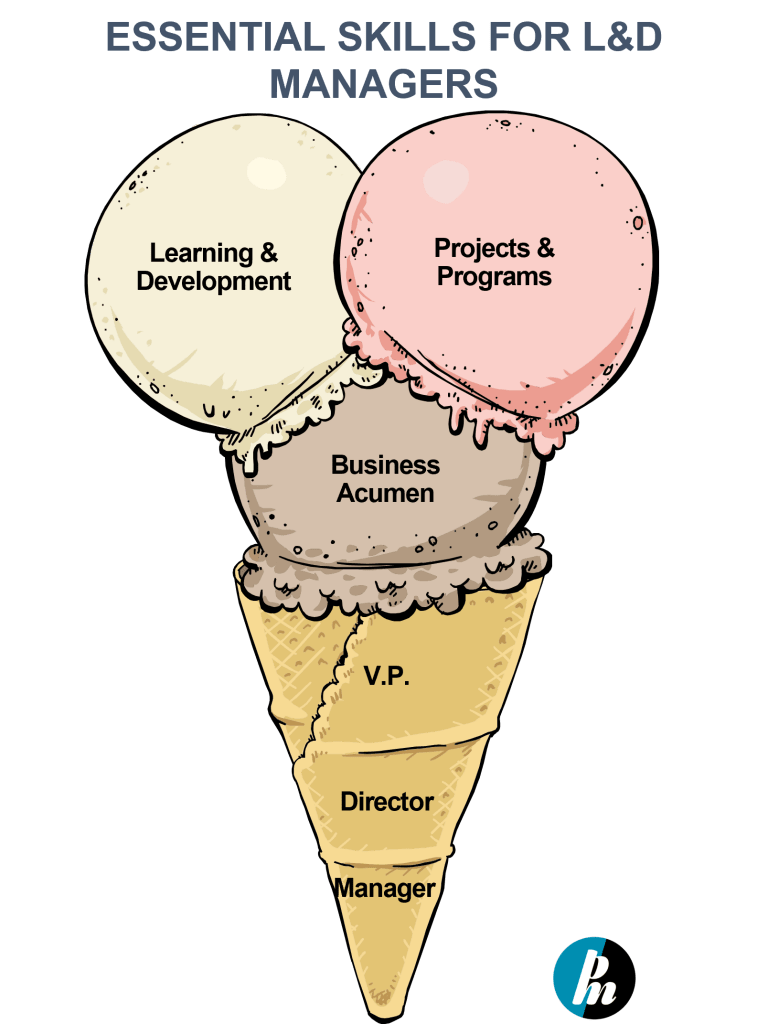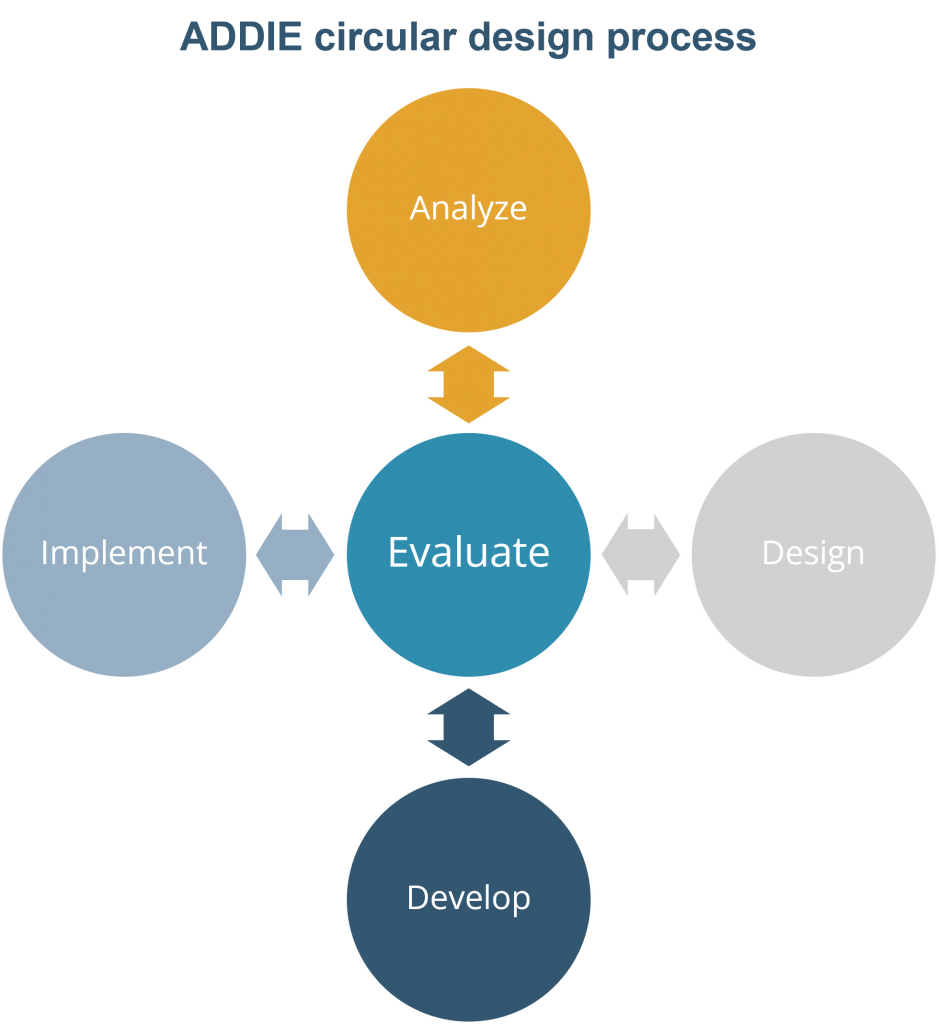In January 2022 my husband moved into a management role. He had been a people manager a decade ago and has been successfully leading a project team for years, but he needed to relearn the people management skills. He had to let go of doing the work himself and start delegating to people on his team. He needed to free up his time from the day-to-day tasks so he could focus on more strategic aspects of leading his team.
This is the journey of all people leaders. With managers who lead the learning and development function, there are specific skills they need to develop to lead the function successfully.
Essential skills for learning and development managers
To lead the learning function successfully, managers need different skills than their team members who design and facilitate training programs. In my previous newsletter, I introduced the ice cream model to provide a framework for these essential skills.
In this newsletter, I want to explore the learning and development scoop specifically and how a manager’s skills differ from a designer’s or facilitator’s skills.

Learning manager and the ADDIE design process
Let’s use the ADDIE design process as the framework for the learning and development.

Evaluate sits in the center of my ADDIE model because it occurs throughout the design and implementation phases and reflects the iterative nature of instructional design. Admittedly, evaluating training is a newsletter or book in itself. I’ll touch on it for each design phase focusing on the manager’s role.
Analyze
Manager’s role
The manager is a liaison between the business and the learning team. They translate business goals into priority projects for their team and identify the metrics for success.
In the analyze phase, the manager creates the conditions for their team and the business unit to work well together. This includes identifying stakeholders and introducing her team members to those individuals. The manager needs to have a process and standard documents to support each team member when meeting with stakeholders. A process provides a consistent experience across the entire team with all stakeholders, which improves the experience and reputation of the L&D team. Standard documents may include standard stakeholder interview questions or an agenda for conducting focus groups. Having standards provides consistency for stakeholders, reduces design time for team members and makes it easier for the manager to review the output since information is summarized in a consistent way.
The output of the analyze phase is a summary of the findings and recommendations for addressing the business (and learning) needs. With a learning and development lens, this document might be called “Training Needs Assessment Recommendations” or “Needs Analysis Summary.” A better term would be “Training Business Case,” which reflects a business lens.
Evaluate
During the analyze phase, evaluation includes working with the business to validate the business need and training approach. It evaluates the learning team’s understanding of the need and recommended solution. As with the analysis, the manager’s role is as a liaison between the business and the learning team.
Design
Manager’s role
In the design phase, the manager’s role is to provide a process and templates for their team to follow. A standardized design process automates repeatable design aspects and frees up time for designers to work on the creative elements. It also reduces the manager’s review time because the information is presented the same way, so time is spent reviewing the course content instead of how the content is presented.
When reviewing the high-level design, the manager provides feedback on:
- Alignment between the course design and the business goals.
- Performance outcomes and actionable learning objectives.
- Delivery approach to ensure consistency with the preliminary cost in the Training Business Case.
- Use of technology.
- Applicability of design and learning activities given the business unit and target audience.
Develop
Manager’s role
As the course is developed, the manager has a less hands-on role. They continue to act as a liaison between their team and the business and step in to provide guidance, contacts, and resolve issues as needed. For example, if the course requires a case study and the instructional designer is unsure who to meet with, the manager can identify the content expert to work with.
As with previous phases, developing the program is more efficient and effective if the manager has an established process and templates for their team.
Evaluate
During the design and development phases, evaluation is focused on the process. The manager’s role as a support and liaison is to work with their team to ensure the course remains within the business case parameters and the project plan – timelines, quality and budget. The manager also liaises with the business to address any escalated issues.
Implement
Manager’s role
If your team designs and delivers training, the manager’s role is to support the implementation by:
- Working with the business to identify the target audience for the pilot.
- Attending pilot and providing feedback.
- Support ongoing implementation as needed.
If your organization has different design and delivery teams, the manager’s role is to establish a process for the handover. For facilitated programs, this may include a train-the-trainer. As mentioned above, the manager helps identify participants for the pilot, attends the pilot and supports ongoing implementation. For elearning courses, a pilot could include thorough user acceptance testing if not completed earlier in the design process. The manager’s role is to ensure the participants represent the target audience.
The manager may also need to support the course transition from the design team to the LMS administrator.
Depending on the program, the solution may shift from a project to a program during the implementation phase. For example, creating an onboarding program would be a project initially. It becomes a program as your team maintains and revises it over time.
Evaluate
During implementation, evaluate is focused on assessing the short-term impact and the longer-term results against the business goals identified by the business and the metrics documented in the Training Business Case.
The manager’s role is to provide a process and template to capture the course data and feedback. They support the designer in analyzing the data to identify the impact and results to communicate with the business. The manager can present initial data as part of a project post-mortem to debrief the design process and the implemented solution.
The shift from an individual contributor to a manager requires a different focus and new responsibilities. Like any manager, a successful training manager needs to move away from doing the work to managing others doing the work. They need to draw on their knowledge of learning and development, skills in managing projects and their overall business acumen to be the link between the business and the learning team. When managers do this, targeted courses directly support business. The learning team and business benefit from a clearer process and a smoother working relationship.
In case you missed it
I’ve shared some additional posts online. I’ve been exploring training from an organization’s perspective and learning from an employee’s perspective. Here they are in case you missed them.
- Business of Training Idea Exchange – Learning and Development – (video link)
- Create a Learning Value Proposition at ATD – (video link)
- Upcoming speaking engagement at asset management conference – (video link)

- Book site – to order your copy or write a review on Amazon: https://trainingthatclicks.ca/
- LinkedIn – read about the journey: #bookbyhannah and #trainingthatclicks.



